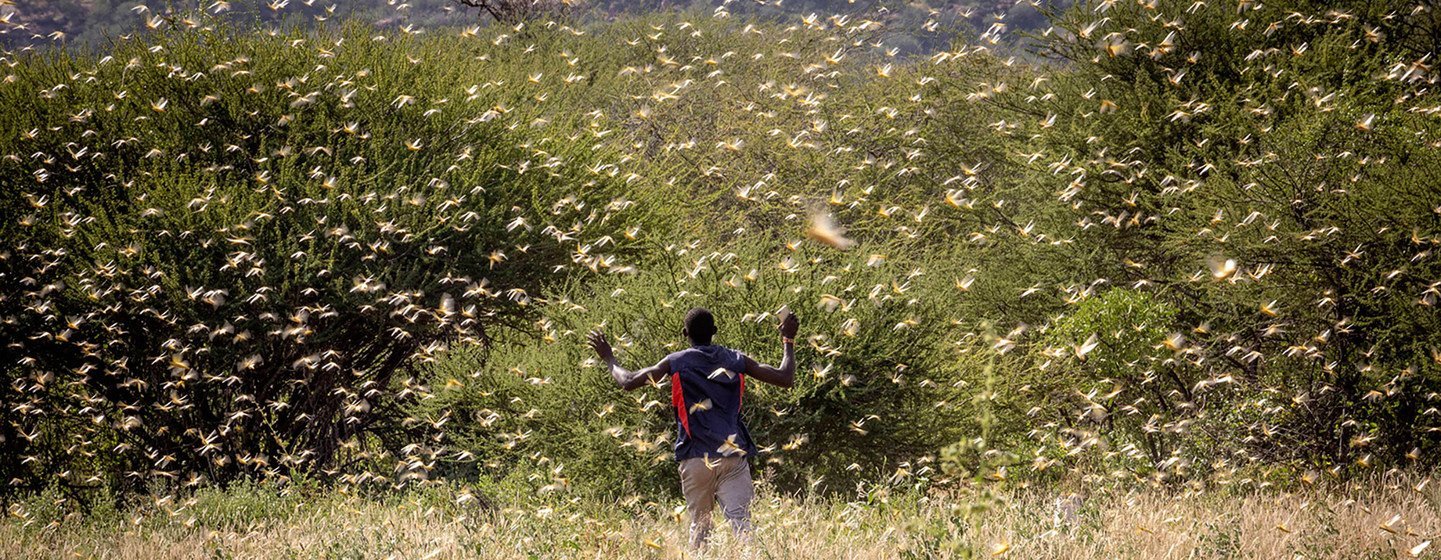From locusts to cyclones: The human cost of interlinked disasters
Many extreme environmental events have a devastating effect on people’s lives, and a new UN report reveals that many of them are linked by the same underlying causes. On the day the study is released, we look at the impact of a locust swarm on a Kenyan farmer, and the ways that Cyclone Amphan affected an Indian worker.
The huge locust swarm which hit the Horn of Africa in the Spring of 2020, and Cyclone Amphan, which struck the border region of India and Bangladesh in May that year, might not seem, on the face of it, to be connected, but a rport released on Wednesday by UN University, the academic and research arm of the UN, shows that there were connected underlying causes: greenhouse gas emissions from human activity, which are affecting the environment in unpredictable ways, and a lack of sufficient disaster risk management.
Both disasters took place in 2020, with the world in the grip of the COVID-19 pandemic, which meant that the effectiveness of the response to both disasters was reduced, with movement restricted for both humanitarians and victims, who also found themselves more financially vulnerable.
Two of the people directly affected have shared their stories with the UN: Susan Mumbi Karanja, a farmer from Nyandarua County, Kenya, and Sudhansu Shekhar Maity, who sells stationery in the Indian city of Kolkata.
Surviving a swarm of biblical proportions
“My name is Susan Mumbi Karanja. I live in a village called Karima, Nyandarua County. I am a farmer, and I have six children.
When the locusts came in March 2020, we saw them coming from the hills. There were so many. They attacked all the food: the cabbages, carrots, potatoes, everything that was on the farm. When they came you could not even see the sun. It would get dark. You could not go to work, the cows could not even eat.
We had heard about the swarm on TV, but we did not think that it would reach us. When it came, the government sent people here, and they sprayed chemicals at the locusts, even where there was food.
We saw that when the chemicals were sprayed some locusts died and others just slept and waited for the sun to rise again. They ate much of the food, which was also destroyed by the chemicals.
When the swarm left there was no food to eat, and none to sell. The cows did not produce milk because there was nothing for them to eat: locusts were everywhere, even in the grass. We couldn’t even eat the locusts, because they had been sprayed with chemicals.
The only thing that can be done is for the government to find out where the locusts are coming from, so they can contain them or burn them. During the swarm, they even sent a helicopter to get rid of them, but it failed and left.
We are wondering what we can do. There can be no planning because of the threat of locusts; it is only the government that can help.”
‘It sounded like a bombardment’: surviving Amphan
“I am Sudhansu Shekhar Maity, and I am from Ramganga village in West Bengal.
Because of the COVID-19 pandemic and subsequent lockdown measures, I had to leave my job in Kolkata in March 2020 and return to my village, where I stayed for six months.
Based on news from different media, there was a sense of terror about the virus spread, and we were scared to step outside.
Obviously, I have faced a major financial crisis. If we stay at home days after days and cannot go to work, how are we going to generate income?
During Cyclone Amphan, we could clearly see the sea from my house, and the water hitting the boundaries was horrific, with 20-25 foot waves. The moment the cyclone started coming closer, we could hear the disturbing noise of heavy wind hitting the windows. It sounded like a bombardment. The river started overflowing and water began entering into the village.
People started running, along with their livestock, such as cows, buffaloes and goats, to save themselves. Most people took shelter in hotels.

When the cyclone passed, I stepped out of my house and all I could see was water: most of the houses were underwater, and the mud-built homes had disintegrated.
Ponds are the most reliable source of water in village areas, we farm fish in these ponds, which is good enough for our yearly consumption. Because of the floods, the ponds were filled by saltwater, and all of the fish died.
All the crops were destroyed due to the cyclone and the flooding. The betel leaf farmers faced the most terrible times due the cyclone: they farm on the baked mud roofs of their homes, and these were all destroyed.
Right after the cyclone, the first thing I could think of was the food and the drinking water. And how we are going to live our life? All our ponds and lands were destroyed. No vegetables and groceries, no connectivity, no electricity, all the roads were blocked and there was no access to the nearest health care centres. With the shortage of drinking water, we had to stand in a long queue to get the well water: there is one well for about 50-60 families.
We have faced really hard times and my savings have been spent during the lockdown. I am still trying to recover from the situation. Around 12,000 families live in our village and most of them have suffered.”

